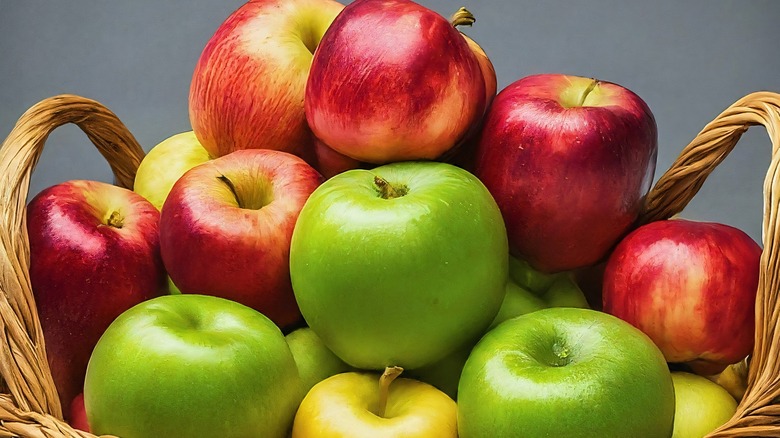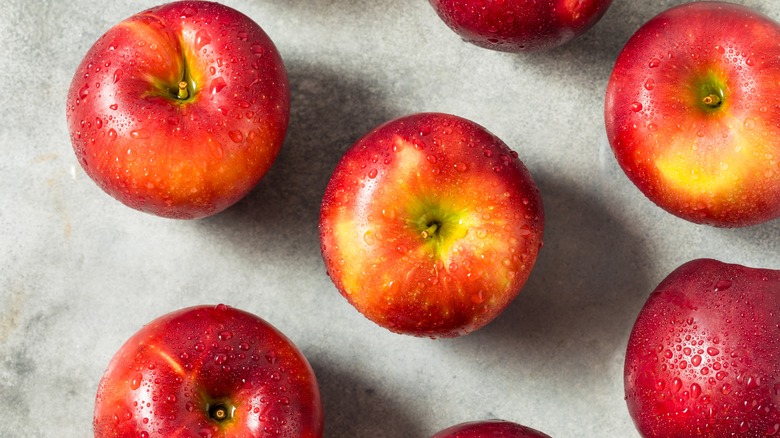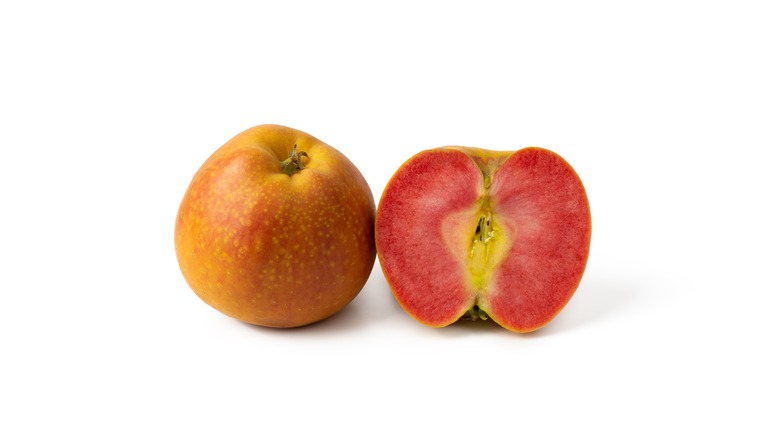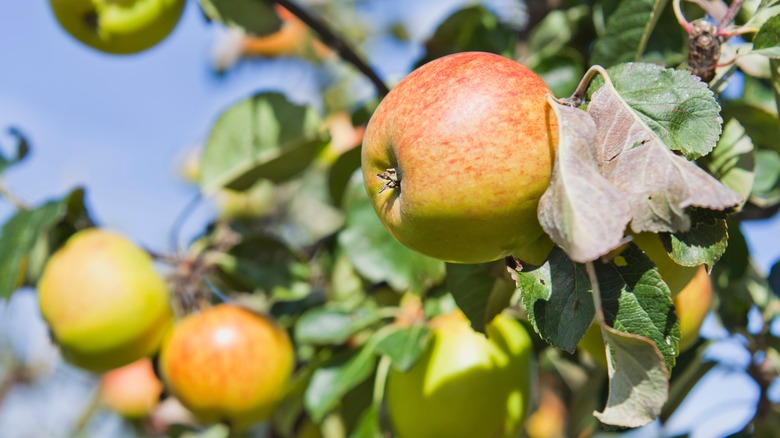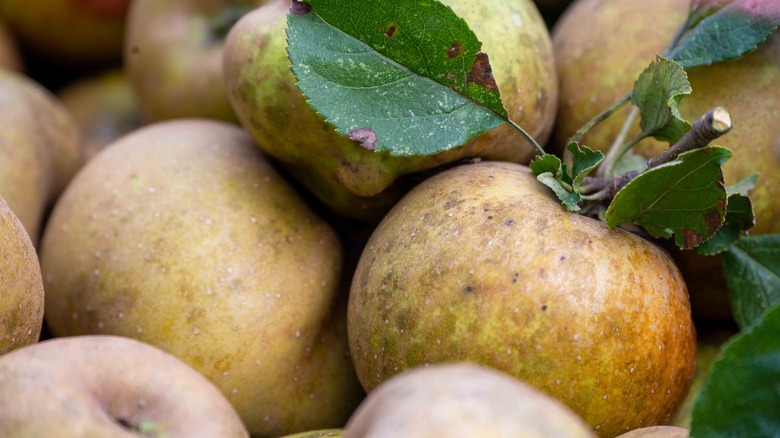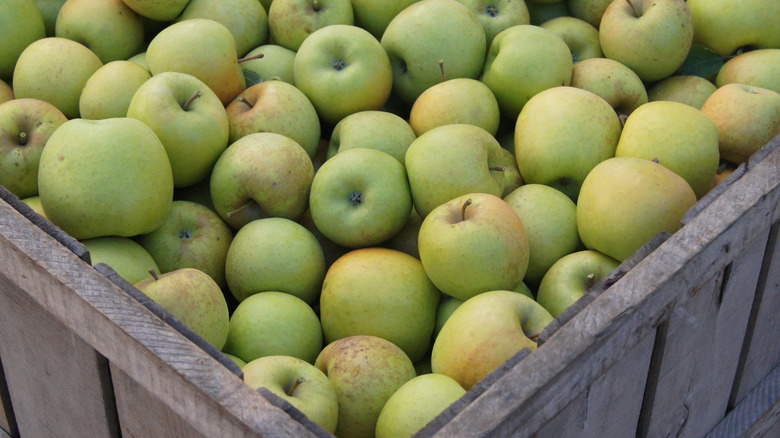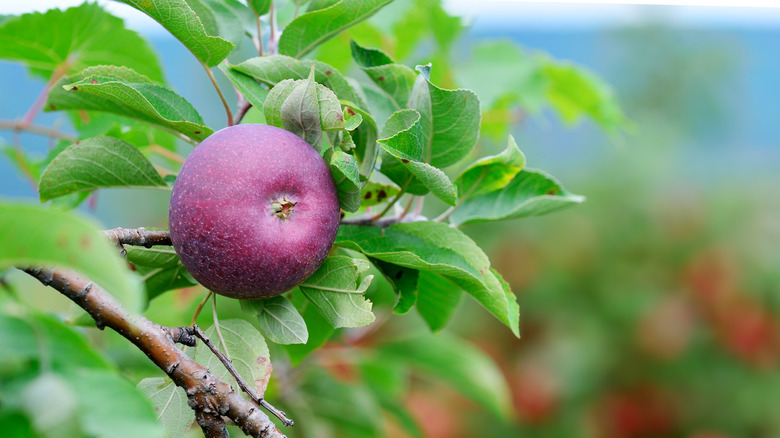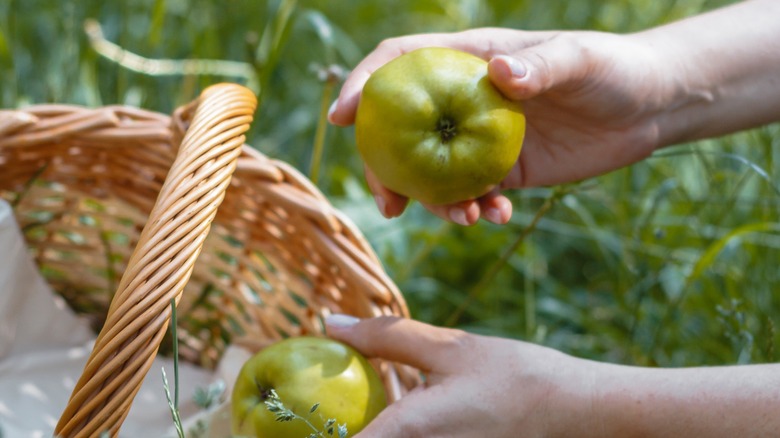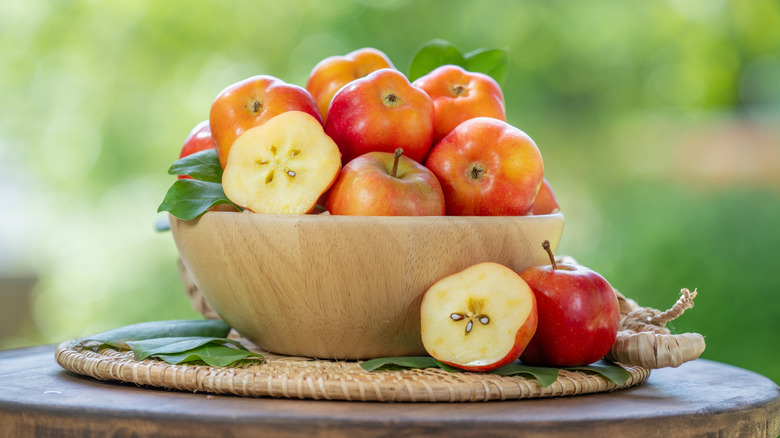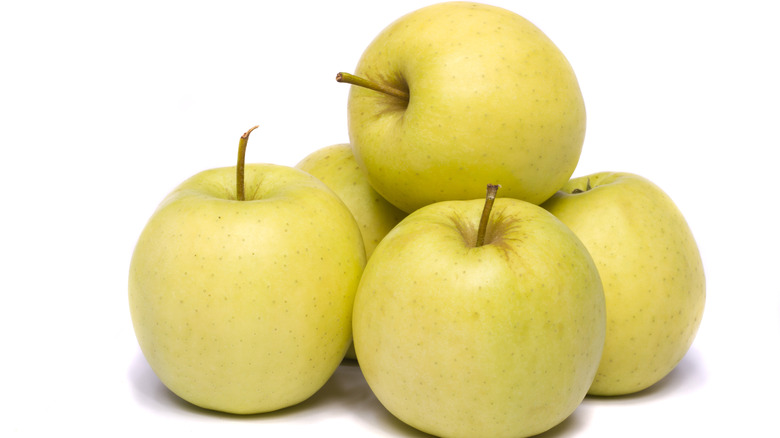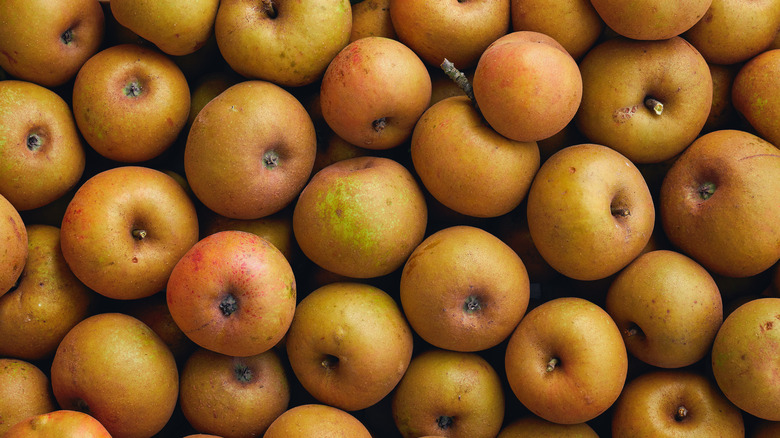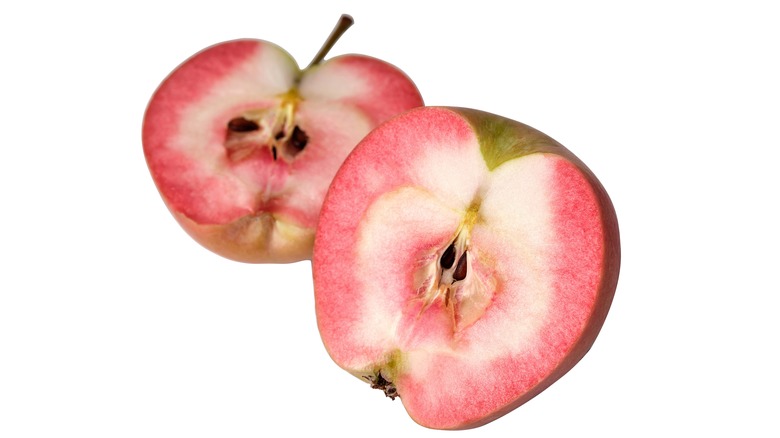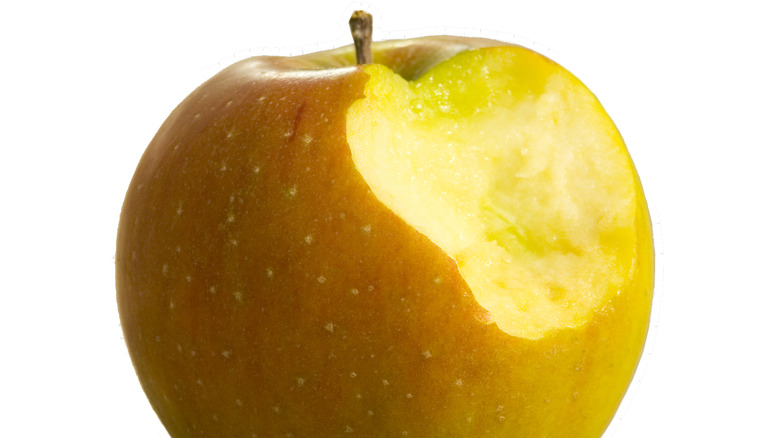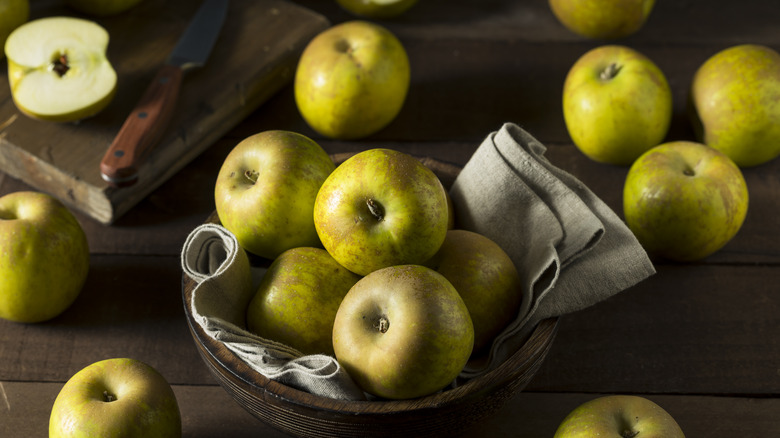13 Varieties Of Apples You Didn't Know Existed
Starting from a kid's school lunch and continuing into adulthood, apples are one of the most popular fruits worldwide, enjoyed for their crisp texture, sweet-tart flavor, and versatility in culinary applications. With over 7,500 known varieties, apples have been cultivated for thousands of years and continue to be a staple in many cultures. But with only a few of these varieties mass-produced, covered in wax and made available in American grocery stores, there are many types of apples you've likely never even heard of, let alone tried.
Living in Quebec, one of Canada's top apple producing regions, has opened my eyes to so many new heirloom varieties. And in my work as a recipe developer for At the Immigrant's Table, I've had the privilege of working with some of North America's top apple producers. And believe me when I say: There's much more to the world of apples than Gala and Red Delicious.
Apples are not a strictly European market. The world's top apple-producing countries include China, the United States, Turkey, Poland, and Italy. These nations — along with others like France, Iran, India, and Japan — contribute significantly to the global apple market. Each region's unique growing conditions influence the characteristics of the apples produced, giving us the dazzling array that is today's apple varieties, with some exciting and unique tastes and appearances. So straight from the tree of knowledge, here are 13 varieties of apples you didn't know existed.
Cosmic Crisp
We're going to start with one of the newest kids on the apple block, the Cosmic Crisp, which has taken the apple world by storm. Developed by Washington State University's tree fruit breeding program, this apple is a cross between the Enterprise and Honeycrisp varieties. It was first released to consumers in 2019 after over 20 years of research and development.
The Cosmic Crisp gets its name from its deep red color with tiny yellow freckles that resemble stars in the night sky. This apple is known for its exceptional sweetness, balanced by a subtle tartness, and its incredibly crisp texture that stays fresh for an extended period, up to four months if stored in the refrigerator crisper drawer. The Cosmic Crisp is also resistant to browning when cut, making it an ideal choice for salads and cheese boards
Pink Pearl
The Pink Pearl apple is a true gem among apple varieties, known for its stunning pink flesh that sets it apart from most other apples. Developed in 1944 by Albert Etter, a California breeder, this apple is a result of crossing the Surprise apple with another unknown variety. The Pink Pearl's exterior is a pale yellow-green color with a slight pink blush, giving little hint of the vibrant pink flesh within. But when cut open, the apple reveals a beautiful pink to red interior that can range from light pink to deep rose.
The Pink Pearl has a tart, sweet flavor with hints of grapefruit and a firm, crisp texture. You can use this apple for baking, as it holds its shape well and imparts a lovely pink hue to tarts, sauces and apple pies, especially alongside cheddar cheese.
Golden Jubilee
The Golden Jubilee is one baking apple that deserves more recognition for its unique qualities. This apple is a cross between Golden Delicious, Grimes Golden and the McIntosh, and is rarely grown outside of France and Canada. The Golden Jubilee gets its name from its beautiful golden-yellow skin, often featuring a slight red blush. This medium to large-sized apple has a sweet, mild flavor with subtle notes of honey and pear. Its flesh is creamy white, fine-grained, and exceptionally juicy.
The texture of the Golden Jubilee is crisp and tender when first picked, making it a pleasure to eat fresh, but unfortunately, it doesn't keep for long. This apple variety holds its shape well when cooked and can be used in various culinary applications. While not as widely available as some commercial varieties, the Golden Jubilee offers a unique taste experience for those lucky enough to find it. We want to try it in Kamala Harris' favorite apple recipe.
Knobbed Russet
The Knobbed Russet apple is one of the most visually distinctive and unusual apple varieties in existence. In fact, if the apple given to Snow White was likely a Red Delicious, then the Knobbed Russet was probably the apple meant to resemble the witch.
Originating in Sussex, England, in the early 1800s, this heirloom variety is often referred to as the "ugly apple" due to its gnarled, bumpy appearance. Its skin is completely covered in a rough, brownish-gray russet, giving it its name, with numerous knobs and protrusions giving it a unique, almost alien-like appearance. Despite its unconventional looks, this apple variety offers a surprisingly pleasant eating experience. The flesh is cream-colored, dense, and crisp, with a sweet-tart flavor that has notes of nuts and pear. While this apple is not commonly found in supermarkets due to its appearance, it's sought after by collectors and those interested in preserving heirloom fruits. Your best bet to try this apple may be to grow it from seed, when it will serve as a reminder that beauty in fruit can come in many forms.
Mutsu
The Mutsu apple, also known as Crispin in some regions, is a Japanese variety that has gained popularity worldwide. Developed in 1930 at the Aomori Apple Experiment Station in Japan, the Mutsu is a cross between Golden Delicious and Indo apple varieties. This large apple has a distinctive appearance with a yellow-green skin that sometimes develops a slight orange or red blush. The Mutsu's flesh is creamy white, very juicy, and crisp with a fine-grained texture. Its flavor is a perfect balance of sweet and tart, with hints of honey and spice.
One of the Mutsu's standout features is its ability to maintain its crisp texture and flavor for an extended period after harvest, making it an excellent storage apple. This variety is highly versatile in the kitchen, suitable for both fresh eating and cooking. The Mutsu tree is known for its vigor and high productivity, making it a favorite among orchardists. It remains one of the most popular dessert apples in Japan, alongside the much more well known Fuji apple.
Black Oxford
Though you may think it's British, the Black Oxford apple is a rare heirloom variety that originated in Paris, located in Oxford County, Maine, in the late 1700s. This unique apple is prized for its striking dark appearance and excellent keeping qualities. The Black Oxford gets its name from its dark purple, almost black skin that is often described as having a purplish bloom similar to that of a plum. The apple's flesh is creamy white with a fine-grained, firm texture. Its flavor is mildly sweet with a subtle tartness and hints of berry, making it a favorite for apple sauce, apple cider or juice.
One of the most remarkable features of the Black Oxford is its exceptional storage ability. When properly stored, these apples can last well into the spring, with some reports of them keeping for up to a year without losing quality. This long storage life made the Black Oxford a valuable apple variety in the days before refrigeration. While not widely cultivated commercially, the Black Oxford has gained a following among apple enthusiasts and is often found in heritage orchards and specialty markets.
Catshead
Continuing the theme of strangely looking apple is the Catshead, which, as its name would suggest, looks like a cat's head. This apple is an ancient English variety that dates back to the 15th century, making it one of the oldest known cultivated apples. The Catshead is a large apple a broad base and a tapered top, and pale green to yellow skin, often featuring a slight russet. Its flesh is creamy white, firm, and coarse-grained with a sharp, acidic flavor that mellows and becomes sweeter as the apple ripens.
The Catshead is primarily known as a cooking apple, excelling in pies, apple tarts, and sauces due to its ability to hold its shape when cooked while developing a pleasant, tangy sweetness. This variety was once widely grown in England but became less common with the introduction of more modern cultivars. Today, the Catshead is considered a heritage variety and is mainly found in specialty orchards and collections dedicated to preserving rare apple varieties.
Api Etoile
The Api Etoile, also known as the Star Apple or Christmas Apple, is a charming and unusual apple variety that originated in France. This small apple is famous for its unique shape, which looks like a flattened rounded star when cut horizontally, giving it its name, as "étoile" means star in French. The Api Etoile has a somewhat compressed shape with smooth, glossy skin that ranges from pale yellow to bright red, depending on sun exposure. Its flesh is crisp, juicy, and fine-grained with a sweet-tart flavor that has hints of almond.
The star-shaped core contains five seed cavities arranged in a perfect star pattern, making for a gorgeous surprise when cut open — that is, if you can get your hands on one. Traditionally, the Api Etoile was popular as a Christmas decoration and gift in France, often hung on Christmas trees or given as presents. While not widely cultivated commercially due to its small size and low yield, the Api Etoile remains a favorite among collectors and those interested in unusual apple varieties.
Ginger Gold
The Ginger Gold apple is another relatively new variety that has quickly gained popularity for its early ripening and excellent flavor. Discovered as a chance seedling in Virginia in the 1960s, this apple is believed to be a cross between Golden Delicious and Albemarle Pippin. The Ginger Gold gets its name from its beautiful golden-yellow skin, which sometimes develops a slight pink blush. This medium to large-sized apple has a conical shape and smooth, waxy skin. Its flesh is creamy white, crisp, and very juicy with a fine-grained texture.
The flavor of the Ginger Gold is sweet with a subtle tartness and hints of spice. It's great when eaten fresh, especially as it's one of the first varieties available for harvest each year in late July to early August, well before most other apple varieties. The Ginger Gold is also known for its resistance to browning when cut, making it ideal for salads and fruit plates.
Zabergau Reinette
The Zabergau Reinette is a unique German apple variety that dates back to the 1880s. This apple is known for its distinctive appearance and complex flavor profile. The Zabergau Reinette has a flattened shape with a greenish-yellow base color that is almost entirely covered with a rough, brown russet. Its flesh is yellowish-white, firm, and fine-grained with a crisp texture.
The flavor of the Zabergau Reinette is rich and complex, combining a sharp acidity that eventually mellows into sweetness with notes of nuts and spices after a month in cold storage. As the apple matures, its flavor becomes more mellow and aromatic. This variety is highly prized for its excellent storage qualities, with properly stored apples maintaining their flavor and texture for several months after harvest. The Zabergau Reinette is perfect in desserts and cider, and has made a name for itself in heritage German cooking. It's similar to another ancient apple, Reinette de France.
Hidden Rose
The Hidden Rose apple, also known as Airlie Red Flesh, is a striking variety that surprises with its vibrant pink-to-red flesh hidden beneath an unassuming yellow skin. Discovered as a chance seedling in the 1960s in Airlie, Oregon, this apple has since gained a cult following among apple enthusiasts. The Hidden Rose's exterior is pale yellow with a slight pink blush, giving little hint of the dramatic color within. When cut open, it reveals a range of pink to deep red flesh, looking for all the world like a particularly glorious sunset. The apple's flavor is tart and sweet with notes of strawberry and lemon, complemented by a crisp, firm texture.
The best part about this apple is that its pink flesh retains its color when cooked, making it ideal for striking desserts and preserves. While not widely available in mainstream markets, the Hidden Rose can be found in specialty stores and farmers markets.
Baldwin
The Baldwin apple is a classic American variety with a rich history dating back to the late 1700s. Discovered as a chance seedling on the farm of John Ball in Wilmington, Massachusetts, it was later named after Colonel Loammi Baldwin, who recognized its potential and began propagating it. The Baldwin quickly became one of the most popular apples in the northeastern United States during the 19th and early 20th centuries.
This medium to large apple has a round to conical shape with thick, tough skin that is primarily red with yellow-green undertones. The flesh is creamy white, crisp, and juicy with a sweet-tart flavor that has hints of spice. Known for its excellent storage qualities and versatility, the Baldwin was once a dominant commercial variety, prized for both fresh eating and cooking. However, a severe winter in 1934 decimated many Baldwin orchards, leading to a decline in its commercial cultivation. Today, the Baldwin is considered a heirloom variety and is mainly found in as a relic in the yard of old homes dating back to the last century.
Golden Russet
The Golden Russet apple is a beloved heirloom variety that has been cultivated in the United States since the mid-19th century. This small to medium-sized apple is easily recognized by its distinctive golden-bronze russeted skin, which gives it a rough, sandpapery texture. Despite its humble appearance, the Golden Russet is prized for its exceptional flavor.
This apple's flesh is fine-grained, crisp, and juicy, with a rich, complex flavor that combines sweetness with a sharp, wine-like quality. The Golden Russet is known for its high sugar content, which made it popular in cider production. Its intense flavor also makes it excellent for fresh eating, particularly for those who appreciate a stronger apple taste. In addition to its uses in baking and cider making, the Golden Russet is valued for its heritage and excellent storage qualities, often lasting well into spring when properly stored.
